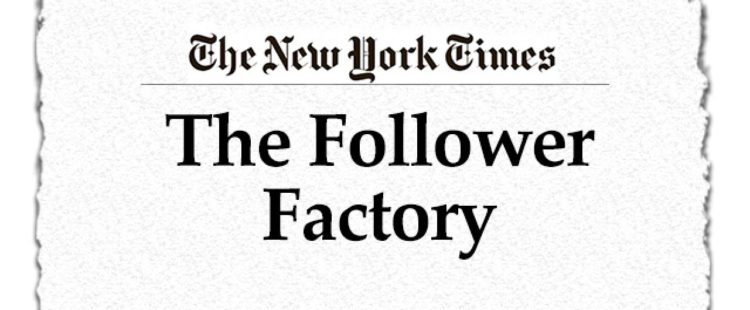Disclosure: I may earn affiliate revenue or commissions if you purchase products from links on my website. The prospect of compensation does not influence what I write about or how my posts are structured. The vast majority of articles on my website do not contain any affiliate links.
Notes: This is an article that I wrote, almost entirely, in February 2018. I never published it. I found it two and a half years later and basically published it as-is.
This week’s New York Times exposé–The Follower Factory–has brought a renewed focus to the phony side of social media. What many people see as an annoying but tolerated part of the experience on Twitter and Instagram was revealed to be a living, breathing industry generating over ten million dollars each year. One of the most embarrassing findings was just how many somewhat-relevant people purchased followers on Twitter and just how useless and bogus most of those followers were. It seems that fakery is ubiquitous throughout social media. But just how deceptive are those follower counts?
Six months ago, I had the opportunity to consult with a social media agency that offered an Instagram growth service. I helped the owners bootstrap their company. In this niche, which is totally dependent on how social media giants fine-tune their spam prevention tools, the sky is falling on a weekly basis. But after the New York Times article, business has never been better.
Allow me to recuse myself–I never built, implemented, or executed any feature that violated Instagram’s terms of service. In fact, most of the company’s revenue, as far as I know, comes from legitimate, not-grey-area sources. However, after countless hours of research and competitor analysis, I think it’s time to talk about just how much of a mirage the whole industry is.
There are dozens of Instagram growth services like the one I helped out with. They cost between $15 – $120 a month and according to the fine print don’t guarantee any results at all. That makes sense, right? If you have an awful Instagram account, even the best promotion won’t get you new followers. Or so one would think.
There are only two segments of the Instagram follower business yet an infinite number of ways to fine-tune parameters to produce the best results.
The first segment is driving fake followers to a customer. This can be done programmatically and without access to the client’s login credentials–if you control fake accounts. But, to control fake accounts, you generally need to create fake accounts. Generating fake accounts is the hard part, and services that boost results using fake followers will purchase them cheaply from foreign primary markets, never having total control. This is the basis of the business profiled in the Follower Factory article.
Think about it this way, if I have access to 10,000 fake accounts, I can write a program that sends between 10 and 30 of them to interact with your Instagram profile each day. I can provide the same service to other customers while cycling through the ten-thousand accounts. You’ll get consistent engagement for, potentially, years. You’ll see results and your account is just another red, grey, or green line in my dashboard.
However, there are big problems with this. Yes, sure, having 5,000 followers does earn you some clout, even these days. But if the followers are bots, you’re basically guaranteed that they will never interact with your content. Further, since they’re bots, and their only purpose is to earn money for some puppetmaster living in a basement, they’ll be pushed to the logical extreme! Some accounts are going to get banned. Phrased another way: over an expanding time horizon, the expected lifespan of a bot goes to zero.
For these reasons, even most of the leading services don’t have direct or indirect access to fake accounts, which is why they rely on segment number two.
If you can log in to a legitimate account, you can generate pseudo-organic interactions by automating targeted commenting, liking, and following. The logic is that when a real user gets an Instagram notification and gets that hit of dopamine, they’re prone to check and see who did that. If they tap and it turns out that your account is compelling, people will be excited that you interacted with them. Some will follow you back! Using even the most primitive automated services would result in hundreds of reciprocal actions per day. So why the hell not?
How has an industry sprung up around this? Sure, if I’m an attractive person with attractive content, people will interact with me. What about the low-quality accounts that are most desperate for followers? If a real person sees a notification and generally decides that the account that took the action seems spammy or isn’t worth following, how can that person gain followers?
When I determined the answer to this question was when I realized this business was built entirely on deceit. By my estimates and research, 75% of reciprocal interactions with an average account running an automated management program are generated by other bots. The other 15% are people in low-income parts of the world who are enthralled by Americans. The remaining 5-10% are people who spend a lot of time on the internet and are in the habit of following back.
If you list Justin Beiber as a targeted page, the algorithm controlling your account will interact with his pictures and with those accounts who have also most recently interacted with his pictures. Seems logical. It turns out that this will lead to a litany of bots all playing grabass with each other.
To prove this theory, I knew I could take a vert scientific route, give you some graphs, whatever. But that would have meant building a fully-fledged automation platform–which, again–I haven’t done. Instead, I bought fake Instagram accounts and manually tested a metric I’ve termed “reciprocity.” Reciprocity is the normalized likelihood of a follow back relative to elapsed time. If you follow Tabasco Hot Sauce on Instagram and get followed by other hot sauce brands within minutes, that’s extremely high reciprocity, one degree removed. Reciprocity doesn’t take into account the attractiveness of an initiating account (yours), instead, it attempts to quantify the automated or whoreish tendencies of interacted-with accounts (theirs).
By basing metrics on reciprocal or, even what we could classify as reflective activity, I was able to reach meaningful conclusions on what accounts may be full-time or part-time bots and, also, the base characteristics I could use to identify users who will be really happy to follow back a generic account.
The sad truth is that nothing you see on the internet is real. Everything–and I mean everything–has been gamed. Famous people hire social media consultants who just buy followers for them. Social media consultants buy followers for themselves. Some genius living in an attic is devising ways to continue to exploit Instagram. Scammy businesses have ways to manipulate reviews. All in the name of looking cool, important, or trustworthy on the internet. When I was first encountering this stuff, it was so easy to distinguish between real and fake. Now it’s big business to the point that they need formulas and machine learning solutions to emulate human behaviors and avoid detection. Paying $20 to boost your social profile isn’t what scares me, it’s what follows…




